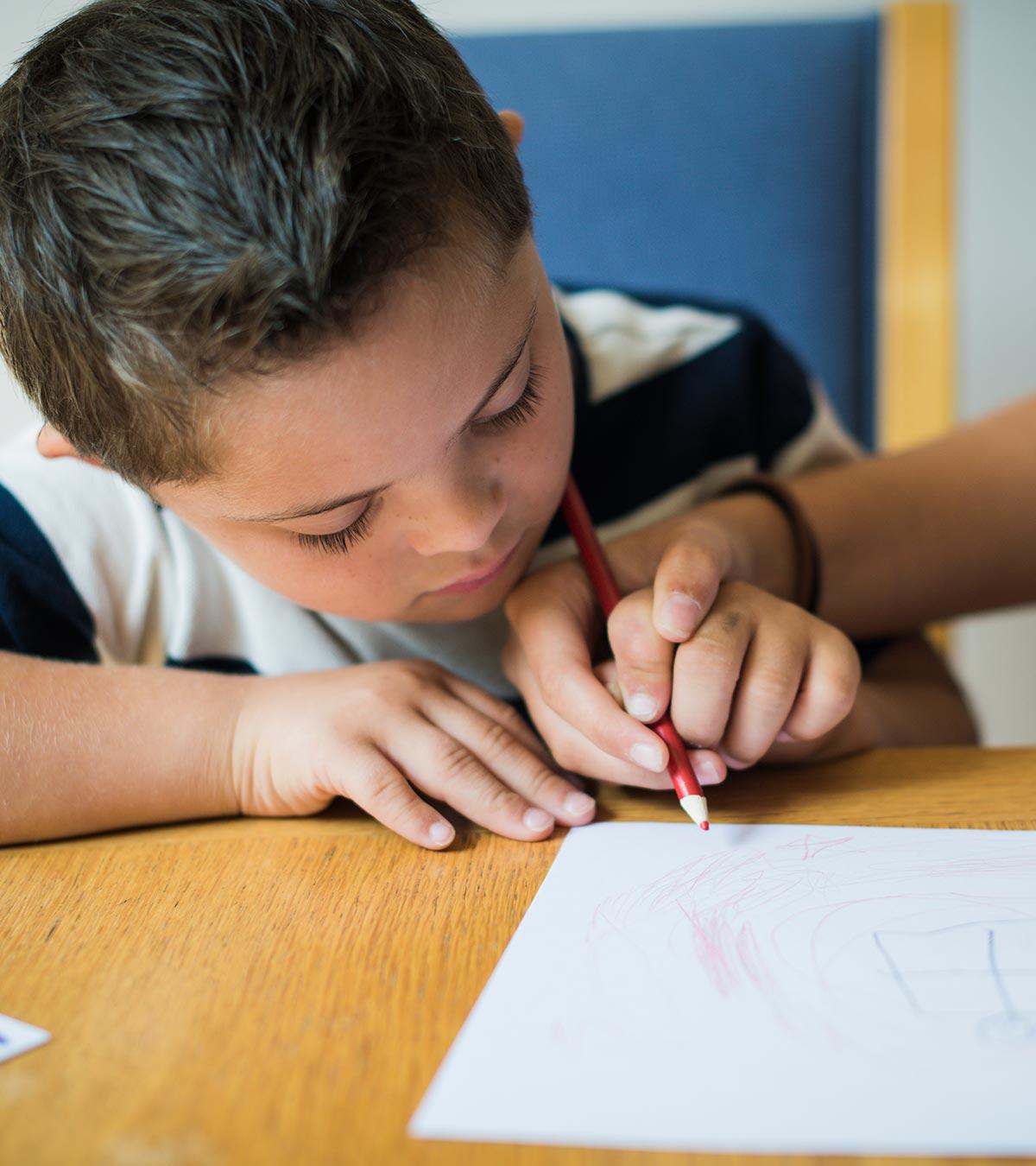
Image: ShutterStock
Making exercise a habit can help children stay active. Therefore, we bring you a list of easy stretching exercises for children to keep them engaged in something positive and productive. Stretching can help calm the mind and enhance concentration. Moreover, it also increases flexibility in the body.
Read on to know more about stretching, including its benefits and different types for children to try.
Benefits Of Stretching For Children
According to the University of California, Davis, stretching or flexibility training helps in calming the mind, refreshing blood flow managing stress, and increasing energy levels. Some more reasons why children need to practice daily stretching exercises are (1) (2):
- Helps children improve their joint health, stability, and mobility.
- Prevents injuries in calf, quadricepsiGroup of muscles present at the front of the thigh that help perform basic lower body movements , and hamstringiGroup of muscles present at the back of the thigh that are responsible for hip, knee, and leg movements and helps in lengthening muscles.
- Reduces muscle tension, delays muscle fatigue, and improves muscular coordination.
- In these times, when everyone is spending more time indoors, children may be sitting at tables or on the floor in one position for a prolonged time, as they do various indoor activities. Here it becomes even more important to exercise as well as stretch muscles.
Simple Stretching Exercises For Children
The World Health Organization advises children to engage in at least 60 minutes of moderate to vigorous physical activity daily. Surprisingly, a staggering 81% of adolescents between the ages of 11 and 17 worldwide do not meet this recommended level of physical activity. Here are some stretching exercises you may teach your children and encourage them to practice regularly.
1. Child’s pose
This posture helps the child to do a full stretch. It can reduce stress and help the kid relax (3).
- Kneel down with knees spread apart and toes touching each other.
- Bend forward to place the forehead on the mat or floor. Stretch the arms forward with the palms extended in front of the head.
- Move the lower half of the body such that the buttocks touch the heels.
- Inhale and exhale slowly in this pose and hold it for about 30 seconds. (make sure the floor is not dusty).
2. Bow pose
One of the significant benefits of bow posture stretching is to improve spine flexibility. Practicing this exercise routine regularly would help in reducing strain in the neck, back, and also release muscle tension. Also, it enhances the blood flow and enhances muscular strength in the upper body (4).
- Lie on the belly with the head towards one side and the hands alongside the body.
- Turn the head to touch the floor with the chin. Exhale, fold the knees, and grab the right ankle with the right hand and left ankle with the left hand.
- Inhale, slowly lift the chest and raise the knees while continuing to hold the ankles with hands.
- Exhale and slowly lower chest and feet. Return to the original position in step one.
3. Cobra pose
Cobra pose helps in relieving backache, improving hunger, and reducing abdominal fat. It can also help in strengthening the stomach and spine (5).
- Lie down on the belly with face down, elbows bent and hands placed next to the face.
- Gently push the hands to the floor and lift the body upwards. Gradually straighten the elbows and raise the head while doing so.
- Put the weight on the palms and raise the upper body.
- The child can hold this position for 10 seconds and come back to the initial position (6).
4. Seated toe touch
This stretching exercise is good for the hamstring and the lower back. It releases hamstring tension, flexes the spine, and improves the motion of hips (7).
- Sit on the floor with legs straight forward and feet next to one another.
- Slowly bend forward and touch the toes with hands. Hold the position for 10-30 seconds and return to the original position.
- Beginners can also perform this exercise while sitting in a chair and legs slightly bent.
5. Downward-facing dog
This stretching exercise for kids strengthens calf muscles and hamstrings. It even helps in calming the brain, energizing the body, and improving digestion (7).
- Rest on all fours, facing downwards.
- Gradually push the weight backward with the hips moving backward too. The hips should remain pushed up in the air.
- The legs remain straight. Keep pushing to the rear until the body forms an inverted V-shape.
- Hold the position for 10-30 seconds before slowly returning to step one.
 Did you know?
Did you know?6. Cat-cow stretch
Practicing the cat-cow stretch regularly helps in bringing mobility in the shoulders, spine, neck, and pelvis. This yoga posture also helps strengthen the spine (8).
- Begin by getting into the table-top position where the child is on all fours and head facing straight. Keep the back straight.
- The arms should be right under the shoulder. Gradually inhale and flex the back downward, as if the back is sagging. The head remains straight and keep looking forward. This is the cow position.
- Gradually exhale, squeeze the back to form an arch,rounding towards the ceiling, and squeeze belly inward. The head also moves simultaneously downwards. This is the cat position.
- Alternate and repeat the cat-cow postures five times or more depending on the child’s preference.
Making exercises more engaging and fun can be a great way to motivate kids to participate. Peter, a dad and fitness enthusiast, shares how he transformed yoga into a delightful bonding experience, “We’ve turned yoga into a fun game by adopting animal personas. Downward dog, cobra, and cat-cow poses are transformed into “Stretching Snake,” “Roaring Lion,” and “Mooing Cow (i).” Approaches like these may help ensure kids have fun while getting the required physical activity.
7. Overhead arm stretch
This simple stretching exercise is good for shoulders, arms, spine, and the overall body. It can be practiced anywhere.
- Stand straight with feet at a normal distance from one another.
- Slowly raise the hands over the head. Open the palms and stretch out the fingers.
- The arms should be in line with the ears. Stretch the arms out as much as possible while the shoulder blades stay in a relaxed state.
- Hold this position for about five seconds.
- Then lower the hands and relax.
8. Crossbody shoulder stretch
This simple exercise comes under static stretches and helps in improving flexibility. When practiced regularly, it even reduces the risk of injury (9).
- Stand straight with feet at a normal distance from one another.
- Raise the right arm and move it towards the left.
- With the left hand, push the right elbow to make the right arm stretch.
- Hold this position for a few seconds. Repeat the same steps with the other arm.
9. Tricep stretch
It helps in stretching the upper arm and shoulder. This exercise can be done either by sitting or standing in one position (10).
- Sit or stand in an upright position.
- Raise the left hand and then bend to touch the center of the upper back (below the neck).
- Use the right hand to support or push the left elbow.
- Repeat by changing arms.
10. Knee lunge
This stretching exercise is good for the lower body. It helps in strengthening calves, hamstrings, quadriceps, back muscles, and abdominals (11).
- Tell your child to stand straight with hands on the waist. The back should be straight in line with the hip.
- Take one step forward. Make sure the knee is in line with the ankle (perpendicular position or 90 degrees of the leg).
- The knee should not go over the toes.
- Squat down with the other leg, which should be in a stretched position (knee of the other leg should be just over the ground).
- This position should be held for a few seconds.
- Repeat the same by changing the legs.
Another variation of a knee lunge is side lunge. Instead of placing a step forward, the step should be on the right and left side.
 Be watchful
Be watchful11. Butterfly stretch
This is a sitting stretch yoga exercise that is good for stretching the inner thighs and helps strengthen the back and maintain balance
(12).
- Sit down with folded legs.
- Bring the feet together such that the soles touch one another.
- Let the knees stretch apart while the soles continue to stay in contact. The back should remain straight and slightly lifted.
- Swing the knees up and down, like flapping wings of a butterfly.
- Keep moving the legs for 10-30 seconds and return to the original position.
According to New York-based pediatric occupational therapist Kimberly Cunningham, “Butterfly stretch is a perfect stretch for kids to do if they’ve got to work on their flexibility in their hip adductor muscles. Basically, this involves pressing the soles of the feet together and then gently pressing the knees downwards towards the floor.”
12. Straddle stretch
Straddle stretch is an active flexibility exercise that is good for hamstrings, quads, and opening hips. There are two types of straddle stretch – seat straddle lotus and side seat straddle (13).
Seated straddle lotus
- Sit down with the soles of the feet together. The knees stay folded and pressed towards the ground.
- Bend forward while placing forearms on the knees.
- Hold the position for 20-30 seconds before returning to the original position.
Side seat straddle
- Sit with legs spread apart in the front.
- Hold the right shin with two hands and lean forward.
- Hold this position for a few seconds and come back to the original position.
- Repeat the same with your left leg.
13. Quadricep stretch
Muscles such as quadriceps, hip flexorsiGroup of muscles present around the front of the hip aiding in lower body movement , calf, and hamstrings may become tight. To avoid the risk of injury, standing quadricep stretch would be a good option (14).
- Stand straight with a chair or a wall at the front.
- Gently fold the leg at the knee to raise the foot backward. Use the hand to hold the foot and stretch backward.
- Hold the position for a few seconds and repeat with the other leg.
 Expert says
Expert says14. Standing calf stretch
Calf stretch helps in improving flexibility, decreasing soreness, and preventing injury. It is an effective exercise for the calf muscles. The exercise can be particularly good for active children (15).
- Stand in front of a wall that is three feet away.
- Place the hands on the wall for support.
- The right foot moves forward while the left foot stretches backward. Keep the hands on the wall
- Stretch leg such that the calf muscle is adequately stretched.
- Hold the position for a few seconds and repeat with the other leg.
15. Hamstring stretch
This stretching exercise helps in keeping the hamstring muscle flexible and even prevents injury (16).
- Sit on the floor and stretch the legs forward.
- The right leg needs to be straight, and the left foot should be folded in such a way that it meets the right inner thigh.
- Bend forward and touch the right knee. Hold the position for a few seconds.
- Come back to the initial position and switch the legs to repeat the same.
16. Crossover Toe Touches
This is a simple stretching exercise that is suitable for beginners and also helps with the stretching of the hamstrings (17).
- Stand straight and make sure your feet are at the hips distance apart.
- Bend forward and extend one of your arms to the toe on the opposite side. The other arm should be straight, facing upwards towards the ceiling.
- Return to the standing position and repeat the above step on the other side.
Safety Measures To Follow While Stretching
Wrong postures or overstretching may harm children. Therefore, parents should teach certain safety tips to children to avoid any injuries (18).
- Warm-up for 10 to 15 minutes before exercising or stretching.
- Stretching should be done before any sports or strenuous physical fitness activities such as swimming, gymming, cycling, running, gymnastics, or playing outdoor games. It is good to do after the activities too.
- Flexibility training should not be done once in a while. Children should be encouraged to practice stretching regularly to maintain balance and improve core strength and flexibility.
- Breathing (inhale and exhale) should be normal when practicing stretching. It is essential not to hold your breath in any case.
- Every stretch needs to be held for about 10 to 30 seconds. There should be no bouncing during the stretch.
- Overstretching is not recommended as it may cause pain.
- Stretching should be done evenly on both sides.
- If any stretch causes consistent pain, there may be an injury in that muscle, and you need to consult your doctor.
- If the child has any medical condition, then talk to the doctor before starting any exercise routine.
Frequently Asked Questions
1. At what age do kids stop being flexible?
Children tend to lose their flexibility or become less flexible around the age of puberty since their bones start to grow rapidly. Therefore, it is important that they stay involved in stretching and other physical activities (19).
2. How can I explain stretching to my child?
You may start by explaining the benefits of stretching and its importance through visual representations such as plucking an apple from the tree or extending the hand to retrieve something from under the couch.
3. Is it normal for a child not to be flexible?
Children are generally more flexible than adults. However, some children with a fast growth spurt may show less flexibility than others. This is more commonly seen in boys when they reach puberty since girls may regain some of their flexibility due to the rise in estrogeniA steroid hormone crucial for the development of female sexual characteristics and reproductive health (20).
Stretching exercises for children help them stay active and increase flexibility. They may also help them calm down, improve blood flow, reduce stress, and be energetic. Stretching can reduce muscle tension and lengthen muscles, preventing various muscle injuries. Child’s pose, bow pose, seated toe touch, cobra pose, downward-facing dog, cat-cow stretch, overhead arm stretch, and crossbody shoulder stretch are some simple stretching exercises for children. It is essential to do warm-ups before stretching and avoid overstretching since it may cause pain.
Infographic: Stretching Exercises – Advantages And Precautions
Stretching exercises are an essential part of a fitness routine for anyone, including children. However, it is important to supervise children while stretching and take safety precautions to prevent any injuries. So, check out the infographic below to learn the benefits of stretching exercises for children and the measures to follow.
Illustration: Momjunction Design Team
Key Pointers
- Stretching is beneficial for children as it keeps them active, flexible and prevents the risk of injuries.
- Besides providing physical benefits, stretching also provides a calming effect and helps children manage stress.
- Some common and easy to follow stretches include downward-facing dog, cobra pose, knee lunge and child’s pose.
- While stretching, some safety precautions to be followed are controlled breathing, stretching evenly and warming up to avoid injuries.
Image: Dall·E/MomJunction Design Team
Let’s get our kids involved in a fun and easy Quick Stretch & Strength Kids Workout. Prepare for an excellent time while strengthening and flexing in a fun way.
Personal Experience: Source
MomJunction articles include first-hand experiences to provide you with better insights through real-life narratives. Here are the sources of personal accounts referenced in this article.
i. Sweat and smiles: fun fitness activities to do with kids;https://medium.com/@orejepeter/sweat-and-smiles-fun-fitness-activities-to-do-with-kids-9ec9a239f19f
References
1. Dr. D. Katz; ABC For Fitness Teacher Manual (2008)
2. Why Stretching is Extremely Important; The Regents of the University of California
3. Stretch for Your Best; Allina Health
4. About Yoga; University of Pittsburgh
5. Benefits of Yoga Poses; Illinois Wesleyan University
6. Healthy Living: Yoga for Kids; University of Arkansas
7. Yoga Part II; The Pennsylvania State University (2018)
8. Yoga Tips; University of Washington
9. Shoulder RTC Simple Stretching and Strengthening; Nicklaus Children’s Hospital
10. 11 Stretches for Athletes; Children’s Hospital Colorado
11. The Undervalued Lunge; National Strength and Conditioning Association
12. Guide To Early Childhood Physical Activity: Motor Skills And Movement Concepts For Children Birth To Five; Missouri Department of Health & Senior Services
13. Workouts to Help Prevent Sports Injuries; Stanford Children’s Health
14. Stretching; Nationwide Children’s
15. Take Time to Stretch; Duke University
16. The importance of stretching; Harvard Health Publishing
17.Exercise safety;Mencap Sport
18. Exercise safety; Victoria State Government
18. Flexibility; University of Nevada
19. Body composition and flexibility; Healthy Children
20. Week Two: Downward Facing Dog/Child’s Pose; Inclusive Yoga; National Center on Health, Physical Activity and Disability
Read full bio of Dr. Nirmala Shireesh Dharap
- Kim Cunningham is a senior occupational therapist at NYC Department of Education. She has served as a Licensed Pediatric Occupational Therapist for over 20 years, with a focus on early childhood development. Kim is the founder and creator of the Hands on Fun OT kit for children.
 Kim Cunningham is a senior occupational therapist at NYC Department of Education. She has served as a Licensed Pediatric Occupational Therapist for over 20 years, with a focus on early childhood development. Kim is the founder and creator of the Hands on Fun OT kit for children.
Kim Cunningham is a senior occupational therapist at NYC Department of Education. She has served as a Licensed Pediatric Occupational Therapist for over 20 years, with a focus on early childhood development. Kim is the founder and creator of the Hands on Fun OT kit for children.
Read full bio of Swati Patwal
Read full bio of Dr. Joyani Das




































